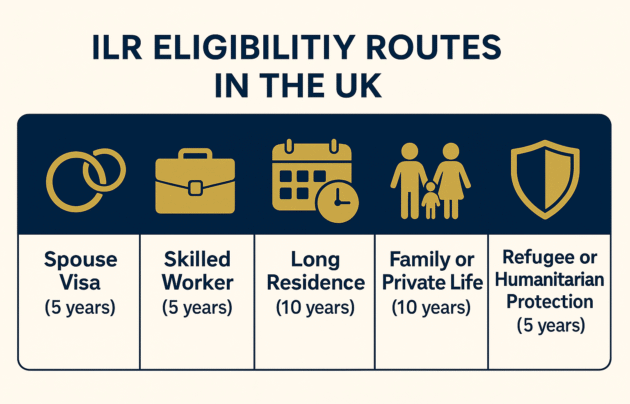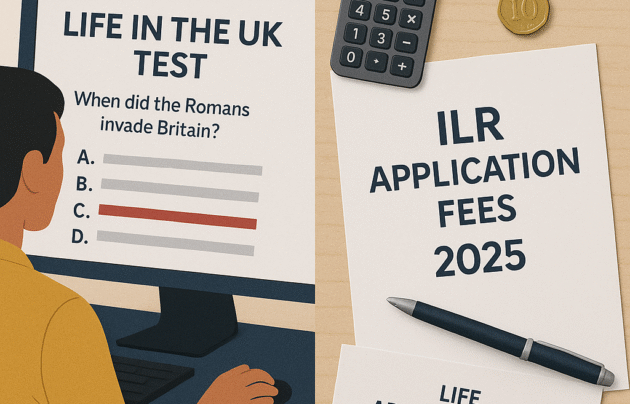If you’ve been living in the UK for several years on a valid visa, you may be ready to apply for Indefinite Leave to Remain (ILR)—a legal status that allows you to settle permanently in the country. ILR is a crucial milestone on your journey to becoming a British citizen, but it requires careful preparation, the right documents, and meeting several eligibility criteria.
In this comprehensive 2025 guide, we’ll break down everything you need to know about applying for ILR in the UK, including eligibility routes, required documents, language and test requirements, application fees, processing timelines, and common mistakes to avoid. Whether you’re applying independently or with help from an immigration solicitor, this guide is designed to make your journey smoother and more successful.
What Is Indefinite Leave to Remain (ILR)?
Indefinite Leave to Remain (ILR), often referred to as “settlement,” allows you to stay in the UK permanently without any visa time limits. With ILR, you can live, work, and study freely, and after 12 months, you may qualify to apply for British citizenship.
Gaining ILR offers long-term stability, personal freedom, and eligibility for certain public services and benefits in the UK. However, it does not grant you a British passport immediately — citizenship is a separate application made after holding ILR for at least a year.
Who Can Apply for ILR in 2025?
You may be eligible for ILR if:
- You have continuously and legally resided in the UK for the required qualifying period, typically 5 or 10 years.
- You hold a valid visa category that leads to settlement (e.g., Spouse Visa, Skilled Worker, or Family/Private Life).
- You satisfy both the English language requirement and the mandatory Life in the UK Test.
- You have a clean immigration record and no serious criminal history.
Each visa category has its own qualifying period and conditions. For example, those on a Spouse Visa typically become eligible after 5 years, whereas applicants under the Long Residence route must complete 10 years of continuous legal residence in the UK.

Common ILR Eligibility Routes
| Visa Type | ILR Eligibility After |
|---|---|
| Spouse or Civil Partner | 5 years |
| Skilled Worker (formerly Tier 2) | 5 years |
| Long Residence | 10 years |
| Family or Private Life | 10 years |
| Refugee or Humanitarian Protection | 5 years |
Note: Fast-track or discretionary routes may be available in certain cases.
Documents You’ll Need for an ILR Application
To strengthen your ILR application, you’ll need to provide a well-organized portfolio of documents. These typically include:
A detailed travel log showing all trips abroad, with exact dates of departure and return.
Make sure your documentation is both accurate and properly labeled to help immigration officers process your case smoothly. Any inconsistencies—such as long absences or expired paperwork, may delay or affect your application. A trusted immigration expert can guide you through the process and double-check that your submission is properly prepared.
Essential Tests for ILR: Life in the UK & English Skills
Passing the Life in the UK Test and demonstrating English proficiency are essential prerequisites for your ILR application.
Life in the UK Test:
To pass the Life in the UK Test, you’ll answer multiple-choice questions over 45 minutes that cover key aspects of British society, including its laws and traditions. Only approved centres are permitted to conduct this test.
- Cost: £50
- Retakes: Allowed (but you must pay each time)
English Language Requirement:
You must prove your English proficiency through either:
- A speaking and listening qualification at the B1 level (e.g., SELT)
- A degree delivered in English may fulfil the language requirement, as long as the UK ENIC officially recognises it.
- Exemption if you’re from a majority English-speaking country
Long-term UK residents are not exempt – both tests must be passed to qualify for ILR, regardless of how long you’ve lived here.

ILR Application Fees in 2025
ILR applications can be costly, especially for families. The following table outlines the estimated fees for ILR applications in 2025:
| Item | Cost (2025) |
|---|---|
| ILR application (standard) | £2,885 |
| Super Priority Service (optional) | £1,000 extra |
| Life in the UK Test | £50 |
| English Test (approx.) | £150 |
Make sure you have funds available, as fee waivers are generally not applicable for settlement applications.
Processing Time
We recommend applying as early as allowed (within 28 days before your qualifying date) to avoid issues with visa expiry or gaps in lawful residence.
Common Mistakes to Avoid
Even strong candidates get refused due to basic errors. Be cautious of the following:
❌ Applying too early or too late
❌ Submitting incorrect or expired documents
❌ Not calculating absences from the UK properly
❌ Failing to meet test or language criteria
❌ Using the wrong form or payment method
These avoidable mistakes can result in your application being delayed or refused – and you’ll lose the fee if that happens. An immigration solicitor can help you navigate the process smoothly and reduce the risk of refusal due to avoidable errors.
Do You Need an Immigration Solicitor?
While ILR applications can be done independently, many applicants prefer professional support, especially for more complex situations. Consider hiring a solicitor if:
- You’ve had visa refusals or overstays
- You’re applying with dependants.
- You’ve been outside the UK frequently
- You’re unsure about which documents are accepted
- You have criminal records or prior breaches
An experienced immigration solicitor can assess your case, help prepare documents, double-check your eligibility, and guide you through the Home Office’s expectations.
When Should You Apply for ILR?
You can submit your ILR application up to 28 days before you reach your qualifying residence period. This means:
- If your visa route requires 5 years, apply within 28 days before the 5-year anniversary of your entry or visa grant.
- Don’t apply too early, or your application may be rejected.
- Don’t wait too long after your visa expires, as this may break your lawful residence and affect your ability to stay in the UK.
What Happens After ILR Is Granted?
Once ILR is approved:
- You are allowed to live and work in the UK freely, without the need for visa renewals.
- You won’t need visa renewals.
- You may become eligible to access public funds, welfare benefits, and NHS healthcare once ILR is granted.
- Upon approval, you’ll be provided with a BRP card confirming your settled status in the UK.
- After one year of having ILR, you may be able to apply for naturalisation as a British citizen, depending on your circumstances.
Note: ILR can be lost if you leave the UK for more than 2 consecutive years — so plan long-term absences carefully.
Final Thoughts
Securing ILR is a significant milestone on your path to permanent residence and eventual British citizenship. While the process involves paperwork, legal checks, and financial planning, a well-prepared application improves your chances of success significantly.
📞 Get Expert Help from Westwing Solicitors
At Westwing Solicitors, we’ve helped hundreds of clients successfully secure ILR. Whether you’re preparing to apply for yourself, your spouse, or your family, our immigration specialists are here to guide you every step of the way.
- Schedule a free 30-minute consultation with our immigration experts today.
- Get your documents reviewed
- Understand your eligibility and avoid rejection
Take the stress out of immigration — contact Westwing Solicitors today.






